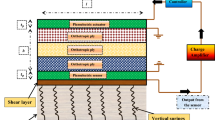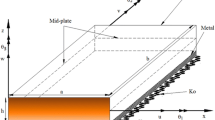Abstract
This paper presents the stress and vibration analysis of advanced composites and sandwich plates supported by elastic foundations. An inter-laminar transverse shear stress continuous plate theory is used to model the deformation responses of the multilayered plates. This plate theory is a refinement of the classical plate theory and utilizes a trigonometric function to define the nonlinear behavior of the transverse shear strains across the thickness of the plates. Additionally, unit step functions are assumed along with some auxiliary variables to satisfy the piecewise continuity requirements of displacements. The deformation behavior of the elastic foundations is modeled using a two-parameter foundation model known as the Pasternak’s foundation. The equations of motion are derived using Hamilton’s principle for the dynamic problem which can also be reduced to a static problem by ignoring the effects of inertia. Two solution schemes are proposed: the Navier-based analytical method, and the finite element method for the spatial solutions of the displacement variables. Further, the solutions in time are obtained using Newmark’s time integration technique. Detailed parametric studies on static, free vibration and forced-vibration analysis of laminated composite plates are carried out to show the effects of the elastic foundations on the structural responses. It is concluded from the results that both analytical and finite element solutions are capable of accurately predicting the responses of composite plates supported by elastic foundations.


























Similar content being viewed by others
Data availability
The raw/processed data required to reproduce these findings cannot be shared at this time as the data also form part of an ongoing study.
References
S. Qaderi, F. Ebrahimi, M. Vinyas, Dynamic analysis of multi-layered composite beams reinforced with graphene platelets resting on two-parameter viscoelastic foundation. Eur. Phys. J. Plus 134, 339 (2019)
Z.X. Lei, L.W. Zhang, K.M. Liew, Free vibration analysis of laminated FG-CNT reinforced composite rectangular plates using the kp-Ritz method. Compos. Struct. 127, 245–259 (2015)
A.M. Zenkour, H.D. El-Shahrany, Frequency control of cross-ply magnetostrictive viscoelastic plates resting on Kerr-type elastic medium. Eur. Phys. J. Plus 136, 634 (2021)
S.S. Akavci, H.R. Yerli, A. Dogan, The first order shear deformation theory for symmetrically laminated composite plates on elastic foundation. Arab. J. Sci. Eng. 32(2), 341 (2007)
H. Tanahashi, Pasternak model formulation of elastic displacements in the case of a rigid circular foundation. J. Asian Archit. Build. Eng. 6(1), 167–173 (2007)
M. Alakel Abazid, 2D magnetic field effect on the thermal buckling of metal foam nanoplates reinforced with FG-GPLs lying on Pasternak foundation in humid environment. Eur. Phys. J. Plus 135, 910 (2020)
A.S. Sayyad, Y.M. Ghugal, Bending, buckling and free vibration of laminated composite and sandwich beams: a critical review of literature. Compos. Struct. 171, 486–504 (2017)
M.M. Alipour, An analytical approach for bending and stress analysis of cross/angle-ply laminated composite plates under arbitrary non-uniform loads and elastic foundations. Arch. Civ. Mech. Eng. 16, 193–210 (2016)
J.L. Mantari, E.V. Granados, An original FSDT to study advanced composites on elastic foundation. Thin-Walled Struct. 107, 80–89 (2016)
J.N. Reddy, A simple higher-order theory for laminated composite plates. J. Appl. Mech. 51, 745–752 (1984)
A. Lal, B.N. Singh, R. Kumar, Static response of laminated composite plates resting on elastic foundation with uncertain system properties. J. Reinf. Plast. Compos. 26(8), 807–829 (2007)
A. Lal, B.N. Singh, R. Kumar, Nonlinear free vibration of laminated composite plates on elastic foundation with random system properties. Int. J. Mech. Sci. 50(7), 1203–1212 (2008)
S.S. Akavci, Analysis of thick laminated composite plates on an elastic foundation with the use of various plate theories. Mech. Compos. Mater. 41(5), 445–460 (2005)
H.S. Shen, J.J. Zheng, X.L. Huang, Dynamic response of shear deformable laminated plates under thermomechanical loading and resting on elastic foundations. Compos. Struct. 60(1), 57–66 (2003)
H.S. Shen, Y. Xiang, F. Lin, Nonlinear bending of functionally graded graphene-reinforced composite laminated plates resting on elastic foundations in thermal environments. Compos. Struct. 170, 80–90 (2017)
H.S. Shen, Y. Xiang, F. Lin, Thermal buckling and postbuckling of functionally graded graphene-reinforced composite laminated plates resting on elastic foundations. Thin-Walled Struct. 118, 229–237 (2017)
A. Chanda, U. Chandel, R. Sahoo, N. Grover, Stress analysis of smart composite plate structures. Proceedings of the Institution of Mechanical Engineers, Part C: Journal of Mechanical Engineering Science, p.0954406220975449 (2020)
M. Bouazza, A.M. Zenkour, Free vibration characteristics of multilayered composite plates in a hygrothermal environment via the refined hyperbolic theory. Eur. Phys. J. Plus 133, 217 (2018)
S.S. Akavci, Buckling and free vibration analysis of symmetric and antisymmetric laminated composite plates on an elastic foundation. J. Reinf. Plast. Compos. 26(18), 1907–1919 (2007)
J.L. Mantari, E.V. Granados, C.G. Soares, Vibrational analysis of advanced composite plates resting on elastic foundation. Compos. B Eng. 66, 407–419 (2014)
A.M. Zenkour, M.N.M. Allam, A.F. Radwan, Effects of hygrothermal conditions on cross-ply laminated plates resting on elastic foundations. Arch. Civ. Mech. Eng. 14, 144–159 (2014)
A.M. Zenkour, M.N.M. Allam, A.F. Radwan, Bending of cross-ply laminated plates resting on elastic foundations under thermo-mechanical loading. Int. J. Mech. Mater. Des. 9(3), 239–251 (2013)
M. Sobhy, Buckling and free vibration of exponentially graded sandwich plates resting on elastic foundations under various boundary conditions. Compos. Struct. 99, 76–87 (2013)
K. Nedri, N. El Meiche, A. Tounsi, Free vibration analysis of laminated composite plates resting on elastic foundations by using a refined hyperbolic shear deformation theory. Mech. Compos. Mater. 49(6), 629–640 (2014)
M.R. Barati, M.H. Sadr, A.M. Zenkour, Buckling analysis of higher order graded smart piezoelectric plates with porosities resting on elastic foundation. Int. J. Mech. Sci. 117, 309–320 (2016)
A. Tounsi, S.U. Al-Dulaijan, M.A. Al-Osta, A. Chikh, M.M. Al-Zahrani, A. Sharif, A. Tounsi, A four variable trigonometric integral plate theory for hygro-thermo-mechanical bending analysis of AFG ceramic-metal plates resting on a two-parameter elastic foundation. Steel Compos. Struct. 34(4), 511–524 (2020)
F.Z. Zaoui, D. Ouinas, A. Tounsi, New 2D and quasi-3D shear deformation theories for free vibration of functionally graded plates on elastic foundations. Compos. B Eng. 159, 231–247 (2019)
M. Kaddari, A. Kaci, A.A. Bousahla, A. Tounsi, F. Bourada, A. Tounsi, E.A. Bedia, M.A. Al-Osta, A study on the structural behaviour of functionally graded porous plates on elastic foundation using a new quasi-3D model: bending and free vibration analysis. Comput. Concr. 25(1), 37–57 (2020)
T. Kant, K. Swaminathan, Analytical solutions for the static analysis of laminated composite and sandwich plates based on a higher order refined theory. Compos. Struct. 56(4), 329–344 (2002)
S. Abrate, M. Di Sciuva, Equivalent single layer theories for composite and sandwich structures: a review. Compos. Struct. 179, 482–494 (2017)
L. Iurlaro, M.D. Gherlone, M. Di Sciuva, A. Tessler, Assessment of the refined zigzag theory for bending, vibration, and buckling of sandwich plates: a comparative study of different theories. Compos. Struct. 106, 777–792 (2013)
D.H. Robbins Jr., J. Reddy, Modelling of thick composites using a layerwise laminate theory. Int. J. Numer. Meth. Eng. 36(4), 655–677 (1993)
H. Hirane, M.O. Belarbi, M.S.A. Houari, A. Tounsi, A., On the layerwise finite element formulation for static and free vibration analysis of functionally graded sandwich plates. Engineering with Computers, pp.1–29 (2021)
M. Di Sciuva, Bending, vibration and buckling of simply supported thick multilayered orthotropic plates: an evaluation of a new displacement model. J. Sound Vib. 105(3), 425–442 (1986)
M. Di Sciuva, Multilayered anisotropic plate models with continuous interlaminar stresses. Compos. Struct. 22(3), 149–167 (1992)
K. Bhaskar, T.K. Varadan, Refinement of higher-order laminated plate theories. AIAA J. 27(12), 1830–1831 (1989)
M. Cho, R. Parmerter, Finite element for composite plate bending based on efficient higher order theory. AIAA J. 32(11), 2241–2248 (1994)
A. Chakrabarti, A.H. Sheikh, Vibration of laminate-faced sandwich plate by a new refined element. J. Aerosp. Eng. 17(3), 123–134 (2004)
A. Chanda, R. Sahoo, Accurate stress analysis of laminated composite and sandwich plates. J. Strain Anal. Eng. Des. 56(2), 96–111 (2021)
J.N. Reddy, Mechanics of Laminated Composite Plates and Shells: Theory and Analysis, 2nd edn. (CRC Press, New York, 2004)
N.J. Pagano, Exact solutions for rectangular bidirectional composites and sandwich plates. J. Compos. Mater. 4(1), 20–34 (1970)
R.D. Cook, Finite Element Modeling for Stress Analysis (Wiley, New York, 1995)
N. Grover, B.N. Singh, D.K. Maiti, Analytical and finite element modeling of laminated composite and sandwich plates: an assessment of a new shear deformation theory for free vibration response. Int. J. Mech. Sci. 67, 89–99 (2013)
M.K. Pandit, A.H. Sheikh, B.N. Singh, An improved higher order zigzag theory for the static analysis of laminated sandwich plate with soft core. Finite Elem. Anal. Des. 44(9–10), 602–610 (2008)
A. Setoodeh, A. Azizi, Bending and free vibration analyses of rectangular laminated composite plates resting on elastic foundation using a refined shear deformation theory. Iran. J. Mater. Form. 2(2), 1–13 (2015)
J.N. Reddy, On the solutions to forced motions of rectangular composite plates. J. Appl. Mech. 49, 403–408 (1982)
A.A. Khdeir, J.N. Reddy, Exact solutions for the transient response of symmetric cross-plylaminates using a higher-order plate theory. Compos. Sci. Technol. 34(3), 205–224 (1989)
A.H. Sheikh, A. Chakrabarti, A new plate bending element based on higher-order shear deformation theory for the analysis of composite plates. Finite Elem. Anal. Des. 39(9), 883–903 (2003)
S. Srinivas, A.K. Rao, Bending, vibration and buckling of simply supported thick orthotropic rectangular plates and laminates. Int. J. Solids Struct. 6(11), 1463–1481 (1970)
A.J.M. Ferreira, Analysis of composite plates using a layerwise theory and multiquadrics discretization. Mech. Adv. Mater. Struct. 12(2), 99–112 (2005)
C.M.C. Roque, A.J.M. Ferreira, R.M.N. Jorge, Modelling of composite and sandwich plates by a trigonometric layerwise deformation theory and radial basis functions. Compos. B Eng. 36(8), 559–572 (2005)
T. Kant, C.P. Arora, J.H. Varaiya, Finite element transient analysis of composite and sandwich plates based on a refined theory and a mode superposition method. Compos. Struct. 22(2), 109–120 (1992)
Author information
Authors and Affiliations
Corresponding author
Appendices
Appendix 1
Rigidity sub-matrices of bending
Rigidity sub-matrices of shear
Appendix 2
Partial differential equation terms of the primary variables
\({{\varvec{\delta}}{\varvec{u}}}_{0}\):
\({{\varvec{\delta}}{\varvec{v}}}_{0}\):
\({{\varvec{\delta}}{\varvec{w}}}_{0}\):
\({\varvec{\delta}}{{\varvec{\beta}}}_{{\varvec{x}}}\):
\({\varvec{\delta}}{{\varvec{\beta}}}_{{\varvec{y}}}\):
Appendix 3
The elements of matrix ‘\(\left[{\varvec{H}}\right]\)’
The nonzero elements of matrix ‘\(\left[{\varvec{B}}\right]\)’ for the ith node are written as
The elements of the vector ‘\(\left[\overline{{\varvec{\varepsilon}} }\right]\)’
Rights and permissions
About this article
Cite this article
Chanda, A.G., Sahoo, R. A study on the stress and vibration characteristics of laminated composite plates resting on elastic foundations using analytical and finite element solutions. Eur. Phys. J. Plus 136, 1186 (2021). https://doi.org/10.1140/epjp/s13360-021-02090-8
Received:
Accepted:
Published:
DOI: https://doi.org/10.1140/epjp/s13360-021-02090-8




